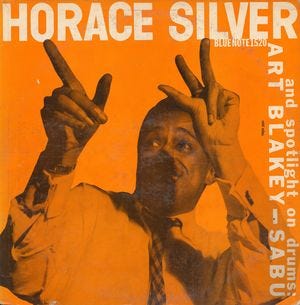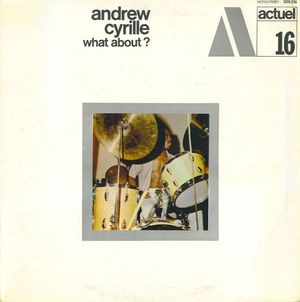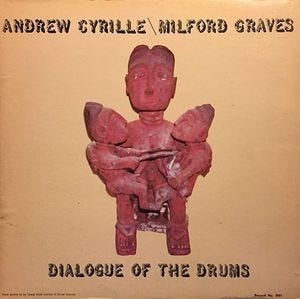Some Jazz Records: Andrew Cyrille Clippings (Solo Drums Special)
Comments on recordings from musicians and other actors of the jazz scene. Random and not-so-random listening cues from the archives.
Baby Dodds, Talking and Drum Solos, Folkways FP 30, 1951, 10" LP; Max Roach, Max Roach Quartet, Debut DLP-13, ca. 1954, 10" LP; Max Roach, Max Roach Septet, Debut EP-451, 1954, 7" EP; and Milford Graves, Milford Graves Percussion Ensemble with Sunny Morgan, ESP-Disk' 1015, 1966, LP.
Andrew Cyrille recorded an unaccompanied drum album titled What About? in 1969. He discussed the precedents of this BYG production with Ron Welburn for Jazz Forum. "It had nothing to do with the BYG people’s suggestions. I wanted to do that," Cyrille said. "There were solo drum albums by drummers before that one. Maybe stylistically that was the first solo percussion album to feature the methods that I used in a solo setting. Baby Dodds made solo recordings; Max Roach made ['Drum Conversation'] and I think one called 'Sfax.' I think Milford Graves had recorded a drum duo with Sonny Morgan for ESP." Baby Dodds’s early 1946 solo recordings first appeared as an album of two 78s on the Disc label. They were reissued in expanded form (with Dodds’s spoken commentary) by Folkways in 1951. Max Roach’s April 1953 solos were released in various forms on the label he cofounded, Debut. They were eventually paired on an Original Jazz Classics CD.
Horace Silver, Horace Silver Trio, Blue Note BLP 1520, 1956, LP.
"Art [Blakey] did a thing with Sabu [Martinez], 'Message from Kenya'; and he did a one-track solo, 'Nothing but the Soul,' on a Horace Silver album with Curley Russell," Cyrille further told Welburn. Blakey’s duet with conga player Sabu Martinez and his trap set solo first appeared on a "Spotlight on Drums" Blue Note single. This material was eventually combined with the November 1953 Horace Silver session during which it was put to tape. Speaking to Ted Panken elsewhere, Cyrille also mentioned the title track of Blakey’s The Freedom Rider.
Chatur Lal, The Drums of India, World Pacific WP-1403, 1961, LP.
"I knew of those things and had heard some," Cyrille continued. "I also listened to the Indian drummers, like Chatur Lal. They have a great tradition of solo drummers; half of their music is based on the drum. And the Africans, without a doubt, with their drum choirs. I had a pretty good idea of people who had done these kinds of things before." Tabla player Chatur Lal appeared on a number of landmark Indian music recordings. One album, The Drums of India, was released under his name on the US market before his premature death at 40.
Andrew Cyrille, What About?, BYG 529.316, 1969, LP.
"I thought about it long and hard and worked out how I could express something that came from my soul and mind which also related to what preceded it, like those things that Art and Max did, even Baby Dodds," Cyrille told Welburn of his own early solo effort. "I thought of five shapes which I could present that I thought would be able to relate to all of those things […] The difference between What About? and maybe what Art did was how he played in the singular 4/4 meter on 'Nothing But the Soul.' I didn’t necessarily think of my recording in terms of 4/4, but I used pressed rolls and various other strokes."
Andrew Cyrille/Milford Graves, Dialogue of the Drums, IPS ST001, 1974, LP.
Andrew Cyrille’s second album under his own name remained drum-centric, but it was a joint effort with fellow drummer Milford Graves. It was taped in January 1974. During a New Musical Express interview the next year, Cyrille responded to a remark about the new album sounding more "African" than What About? "That was intentional because we wanted to let people know we were in touch with other cultures, and that there is a basis for what we do," Cyrille said. "We also did some bebop things at the concert, scatting phrases, shoobop ada bam bam, that sort of thing. The concert was planned as an evolution of the drum—in an hour and 15 minutes. There has been a lot of music with just the trap set itself, which is as formidable as any instrument, but we decided to use other percussion as well. I had access to any amount of chimes and gongs and castanets etc. through my association with Antioch College—Jimmy [Lyons] and Cecil [Taylor] and I were all artists-in-residence there—and Milford has a collection of African instruments like the balafon."










